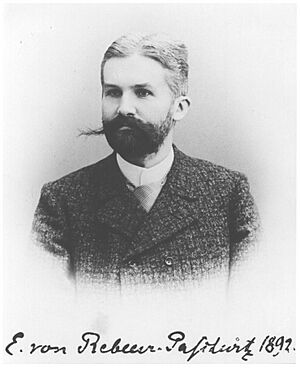Ernst von Rebeur-Paschwitz facts for kids
Quick facts for kids
Ernst von Rebeur-Paschwitz
|
|
|---|---|
 |
|
| Born | 9 August 1861 |
| Died | 1 October 1895 (aged 34) Merseburg, Germany
|
| Citizenship | German |
| Alma mater | Humboldt University of Berlin |
| Known for | the first recording of teleseism with the use of his sensitive self-registering horizontal pendulums in 1889 |
| Scientific career | |
| Fields | seismology, geophysics, astronomy |
Ernst von Rebeur-Paschwitz (born August 9, 1861 – died October 1, 1895) was a German scientist. He studied stars (astronomy), the Earth's physical processes (geophysics), and earthquakes (seismology). He is famous for being the first person to record a "teleseism" in 1889. A teleseism is an earthquake whose waves travel a very long distance. He used special tools called sensitive horizontal pendulums for this. His ideas helped create a worldwide network of stations to study earthquakes. This led to the start of the International Seismological Association.
Life Story
Ernst von Rebeur-Paschwitz was born on August 9, 1861, in Frankfurt/Oder, Germany. His father was a government officer. Because of his father's job, Ernst often changed schools. He went to schools in Legnica, Wrocław, and Frankfurt/Oder.
Later, Ernst studied math and astronomy in Leipzig. He also traveled to England and Ireland. He continued his studies in Berlin and Geneva. He took a one-year break to serve in the military. In 1883, he earned his doctorate degree from the Humboldt University of Berlin. His main topic was about how comets move. After that, he became an assistant at an observatory.
In 1884, Ernst started having health problems. He received treatment in Switzerland, Italy, and on Tenerife. His throat and chest issues made it hard for him to give lectures. From 1891, he was mostly confined to his bed. He only left his room during the summer months.
Ernst von Rebeur-Paschwitz died from tuberculosis on October 1, 1895. He was in Merseburg, and he was only 34 years old.
Amazing Pendulums
In 1885, Ernst worked at the Karlsruhe Institute of Technology. He became very interested in a special pendulum invented by Friedrich Zöllner. In 1886, Ernst started building his own horizontal pendulum. He built it at the astronomical observatory in Karlsruhe. His goal was to measure tiny wobbles of the Earth's surface. These wobbles were thought to be caused by planets and stars. His pendulum could also detect small sideways movements of the ground.
Ernst von Rebeur-Paschwitz was the first person to continuously record ground movements. He did this by using photographic paper. Between 1886 and 1895, he created three different models of his pendulums. He worked with three different companies to build them.
Ernst placed one of his pendulums in Potsdam. He put the second one in Wilhelmshaven, near the North Sea. These pendulums were designed to measure the horizontal motion of the ground. This motion was thought to be caused by the moon's tides.
On April 17, 1889, something amazing happened. He recorded very strong movements on both instruments. At the same time, a powerful earthquake happened near Tokyo, Japan. Just 64 minutes after the earthquake was recorded in Tokyo, Ernst saw a disturbance on his instruments. This meant the earthquake waves had traveled over 5,000 miles through the Earth! They moved at a speed of more than a mile per second.
Ernst von Rebeur-Paschwitz was the first to detect earthquake vibrations that had passed through the inside of the Earth. Before this, only nearby earthquake shakes had been recorded. This was the first time waves from a faraway earthquake were registered. Realizing that strong earthquakes could be recorded from great distances changed everything. It helped start the modern study of seismology and the physics of the Earth's interior. This discovery made seismology a global science.
Working Together Globally
Ernst von Rebeur-Paschwitz understood that studying earthquakes needed teamwork from scientists all over the world. In 1895, at the International Geographical Congress, he suggested creating a global network of earthquake stations. These stations would all use the same type of horizontal pendulums. Because of his idea, an English scientist named John Milne set up a network of simple pendulum stations in British colonies.
In his last published work that same year, Ernst also argued for setting up an international office. This office would collect all the earthquake observations from around the world.
After Ernst's death, another scientist named Georg C. K. Gerland shared Ernst's ideas. He did this at a conference in London in 1895. Georg Gerland then organized the first International Conference of Seismology in Strasbourg in 1901. This was the beginning of global cooperation in seismology. Two years later, it led to the founding of the International Seismological Association. This organization is now called the International Association of Seismology and Physics of the Earth’s Interior (IASPEI).
Special Medal
The Ernst von Rebeur-Paschwitz Medal is a special award. The German Geophysical Society gives it to scientists who have made amazing discoveries in geophysics. Some recent winners include:
- 2017: Lev Vinnik, Moscow
- 2015: Rongjiang Wang, Potsdam
- 2008: Winfried Hanka, Potsdam
- 2007: Karl Hinz, Hanover
- 2004: Walter Zürn, Schiltach / Karlsruhe


